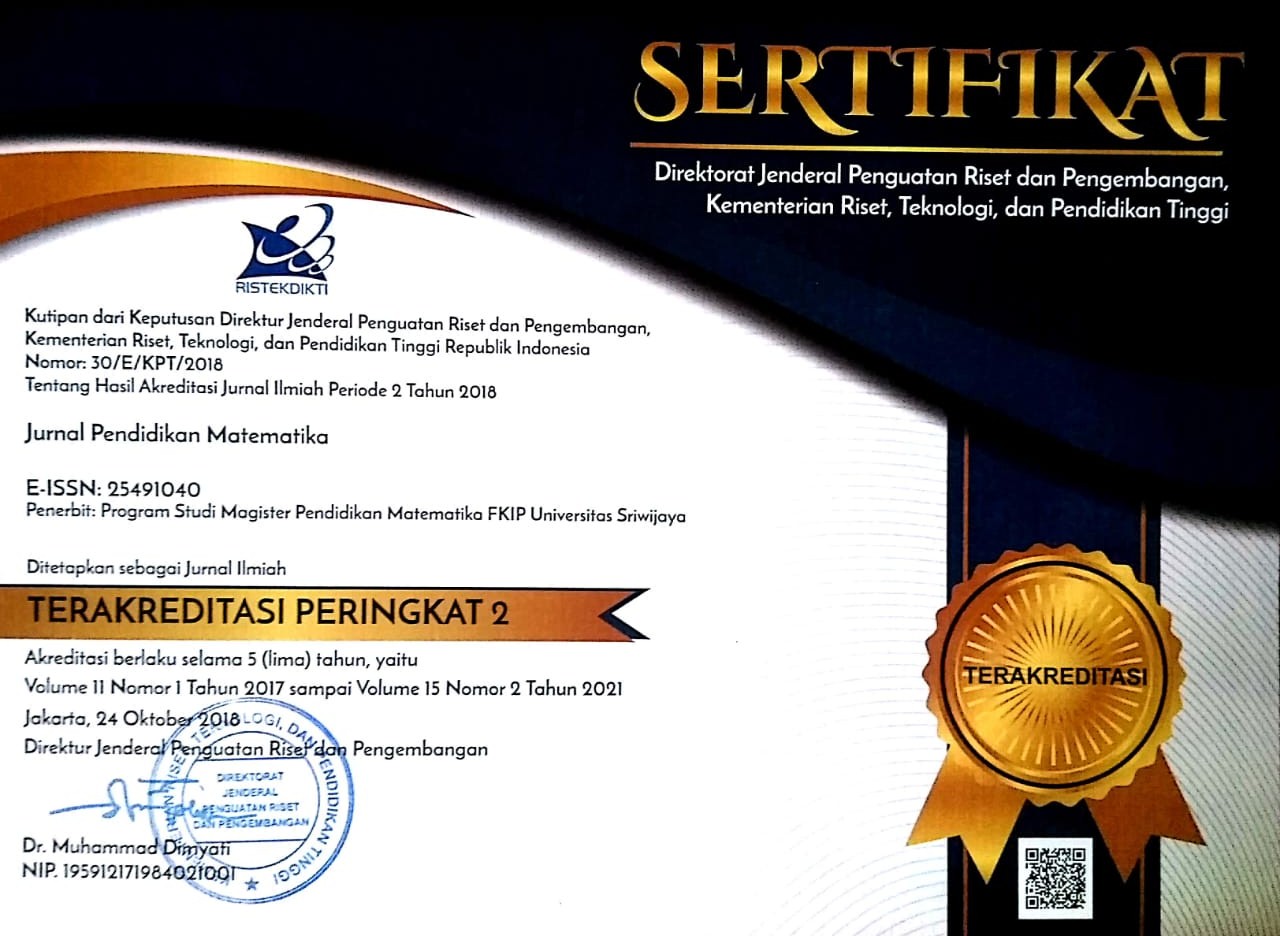Students’ Ability in Solving Statistical Problem Using the Context of the COVID-19 Pandemic
Abstract
This study aims to determine mathematical abilities of the students in grade 8 in solving statistical problem using RME and LSLC in online learning during the COVID-19 pandemic. Learning began with the provision of were given interactive videos as an asynchronous pre-learning stage. Furthermore, at the synchronous stage, students were given sharing tasks and jumping tasks then synchronous activities were closed by giving independent assignments. In asynchronous pre-learning, students sent independent assignments via Google Classroom at a predetermined time. Subjects in this study were 31 eight graders junior high school students. This research used a descriptive method, where the data were obtained by using observation, test, and interview. The data were analyzed qualitatively descriptively.The result of this study is students’ abilities in a good category with an average 68,5. Therefore, it is concluded that RME and LSLC are suitable for use during a pandemic as teaching methods for statistics.
Keywords
Full Text:
PDFReferences
Ahmad, I. F. (2020). Alternative assesment for distance learning in the emergency Coronavirus Disease (COVID-19) in Indonesia [in Bahasa]. PEDAGOGIK: Jurnal Pendidikan, 7(10), 195-222. https://doi.org/10.33650/pjp.v7i1.1136
Annizar, A. M. R., Maulyda, M. A., Khairunnisa, G. F., & Hijriani, L. (2020). Students' mathematical problem solving ability in solving PISA problems on geometry topics [in Bahasa]. Jurnal Elemen, 6(1), 39-55. https://doi.org/10.29408/jel.v6i1.1688
Budiarti, M. I. E. (2016). Analysis of the geometry problem solving process based on Van Hiele’s theory [in Bahasa]. Qalam: Jurnal Ilmu Kependidikan, 5(2), 33-43.
Fauzi, A. (2019). Reasoning and problem solving skills through collaborative models and mind want to know inquiring strategies on statistics material in grade VIII [in Bahasa]. Jurnal Penelitian, Pendidikan dan Pembelajaran, 14(6). http://riset.unisma.ac.id/index.php/jp3/article/view/3748
Juliana, H. S. & Zanthy, L. S. (2020). Difficulty analysis of class IX students of MTs in West Bandung in completing statistical material problems [in Bahasa]. Jurnal Cendikia: Jurnal Pendidikan Matematika, 4(1), 183-192. https://doi.org/10.31004/cendekia.v4i1.172
Meitrilova, A. & Putri, R. I. I. (2020). Learning design using PMRI to teach central tendency materials. Journal of Physics Conference Series, 1470(1), 012086. https://doi.org/10.1088/1742-6596/1470/1/012086
Mita, D. S., Linda R. T., & Nur, I. (2019). Analysis of students' problem solving ability in solving PISA questions [in Bahasa]. Lentera Sriwijaya, 1(2), 25-33. https://doi.org/10.36706/jls.v1i2.10025
MoEC. (2020). MCA and its implications for learning [in Bahasa]. Jakarta: Pusmenjar Kemdikbud.
Octriana, I., Putri, R. I., & Nurjannah. (2018). Student’s mathematical reasoning uses PMRI and LSLC approaches on number pattern materials in grade VIII. [in Bahasa]. Jurnal Pendidikan Matematika, https://doi.org/10.22342/jpm.13.2.6714.131-142
OECD. (2019). PISA 2018 Result (Volume 1): What students know and can do, PISA. Paris: OECD Publishing. https://doi.org/10.1787/5f07c754-en
Permatasari, R. & Putri, R. I. I., & Zulkardi. (2018). PISA-like: Football context in Asian Games. Journal on Mathematics Education, 9(2), 271-280. https://doi.org/10.22342/jme.9.2.5251.271-280
Putri, R. I. I., & Zulkardi. (2018). Noticing students’ thinking and quality of interactivity during mathematics learning. Proceeding in International Conference on Education 2017 (ICE 2017), 549-553. Palu: Universitas Tadulako. https://doi.org/10.2991/ice-17.2018.118
Rahman, A. (2019). Let’s check out Nadiem Makarim’s ideas about education [in Bahasa]. https://m.cyberthreat.id/read/3533/Yuk-Simak-Gagasan-Nadiem-Makarim-Soal-Pendidikan. Retrieved from 4 Februari 2020
Rahmawati, K. (2016). Moodle-based E-Learning development as a social science learning resource for grade VII junior high school sub-theme of economic activities and utilization of natural resources [in Bahasa]. Unpublished Thesis: University of Sriwijaya
Sari, W., Rifki, A. M., & Karmila, M. (2020). Analysis of education policies related to the implementation of distance learning in the emergency of COVID-19 [in Bahasa]. JURNAL MAPPESONA, 2(2). https://jurnal.iain-bone.ac.id/index.php/mappesona/article/view/830
Sato. (2014). Dialogue and collaboration in junior high schools: Learning community practices. Japan: JICA
Sembiring, R. K. (2010). Indonesian Realistic Mathematics Education (PMRI): Developments and challenges [in Bahasa]. Journal on Mathematics Education, 1(1), 11-16. https://doi.org/10.22342/jme.1.1.791.11-16
Situmorang, K., Putri, R. I. I., & Lelyana, C. K. (2020). Analysis of student HOTS on number patterns using the PMRI approach through the LSLC system. Jurnal Elemen, 6(2), 333-345. https://doi.org/10.29408/jel.v6i2.2213
Son, A. L., Darhim, & Fatimah, S. (2020). Students’ mathematical problem-solving ability based on teaching models intervention and cognitive style. Journal on Mathematics Education, 11(2), 209-222. https://doi.org/10.22342/jme.11.2.10744.209-222
Surya, A., Zulkardi., & Somakim (2017). Statisticas learning design using mall context in grade 5 [in Bahasa]. Jurnal Elemen, 3(2), 149-165. https://doi.org/10.29408/jel.v3i2.344
Wafiqoh, R., Darmawijoyo, & Hartono, Y. (2016). LKS based on eliciting activities model to know mathematics problem solving ability in class VIII [in Bahasa]. Jurnal Elemen, 2(1), 39-55. https://doi.org/1029408/jel.v2i1.176
Wahyuni, F. A. (2018). Blended learning two methods: (Synchronous and asynchronous) for writing material argumentative essay [in Bahasa]. JINOTEP (Jurnal Inovasi dan Teknologi Pembelajaran): Kajian dan Riset Dalam Teknologi Pembelajaran, 3(2), 137-143. http://dx.doi.org/10.17977/um031v3i22017p137
Wardani, D. N., Toelioe, A. J., & Wedi, A. (2018). The attraction of learning in the 21st era with blended learning [in Bahasa]. Jurnal Kajian Teknologi Pendidikan, 1(1), 13-18. http://journal2.um.ac.id/index.php/jktp/article/view/2852
Yusuf, Y., Titat, N., & Yuliawati, T. (2017). Analysis of the learning obstacle in junior high school students on statistics material [in Bahasa]. AKSIOMA: Jurnal Matematika dan Pendidikan Matematika, 8(1), 76-86. https://doi.org/10.26877/aks.v8i1.1509
DOI: https://doi.org/10.22342/jpm.16.2.14162.215-226
Jl. Srijaya Negara, Bukit Besar
Palembang - 30139 Indonesia
Jurnal Pendidikan Matematika is licensed under a Creative Commons Attribution-NonCommercial-ShareAlike 4.0 International License.
Indexed in:


